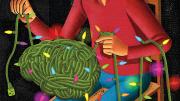In scale and scope, this is an effort that may eventually surpass even the Human Genome Project. Since President Obama’s April announcement of a new federal initiative to accelerate research on mapping brain activity, an advisory group of scientists has been deciding how best to deploy this boon for neuroscience research.
The Brain Research through Advancing Innovative Neurotechnologies (BRAIN) Initiative, a multiyear project launched with $110 million of federal funding in its first year, grew out of a proposal by six scientists, including George Church, Winthrop professor of genetics at Harvard Medical School. In a paper published in the scientific journal Neuron last June, they advocated an international public effort—much like the Human Genome Project—to create a Brain Activity Map by reconstructing the activity of every neuron in a large interconnected group of cells. They suggested the research might start by examining the fruit-fly brain’s medulla, with 15,000 neurons, and work up to part of the mammalian brain, with several million. (Although researchers have already recorded and studied the activity of smaller groups of neurons, many brain processes are thought to require much larger regions of brain cells working in concert.)
In launching the initiative, National Institutes of Health (NIH) director Francis Collins announced a working group—a “dream team” of 15 scientists—who would be charged with deciding the details of its goals and funding. Among them is Tarr professor of molecular and cellular biology Joshua Sanes, who says the committee is meeting through the summer to create an interim plan for this year, to be followed by a long-term plan next year. At present, federal support for the initiative is to be shared by three government agencies: the NIH ($40 million), the Defense Advanced Research Projects Agency ($50 million), and the National Science Foundation ($20 million). Additional funding totaling more than $122 million annually has been pledged by private foundations: the Allen Institute for Brain Science, the Howard Hughes Medical Institute, the Kavli Foundation, and the Salk Institute for Biological Studies.
Sanes says that, like the Human Genome Project, which boosted existing efforts to decipher the entire sequence of DNA in human chromosomes, the BRAIN Initiative will “coordinate, focus, and enhance efforts toward goals neuroscientists already agree are very valuable”—the building of tools that will enable more detailed studies of brain activity. The original Brain Activity Map proposed by Church and his colleagues will be considered, but Sanes reports that the committee is keeping an open mind and will solicit expert input on how best to focus the effort.
So far, the announcement has generated a mix of excitement, skepticism, and confusion among scientists, in part because the details, such as how funds will be distributed, what the specific goals will be, and how they’ll be accomplished, are still unclear. A major question concerns the scope of the effort. “My own hope is that we try to make a big impact in a limited area that we think is very important,” Sanes says. One open question, for instance, is whether to focus on mapping “functional” connections—recording the activity of many brain cells as they fire in order to understand how their actions interrelate—versus visualizing the structural connections among neurons, often called the “connectome.”
The ultimate goal of recording the activity of the tens of billions of neurons in the human brain seems unworkable. But Sanes points out that “even achieving the first steps was unimaginable a few years ago.” New technologies have made it possible to record ever-increasing numbers of cells, and a leap in computing power allows scientists to collect and analyze the huge amounts of data such recordings generate.
Sanes believes that this is a good time to build on those advances. How the actions of brain cells generate the mental activities of the brain remains a mystery—and “as a purely scientific challenge,” he says, “I believe, and many people believe, this is the biggest challenge of the century.”








